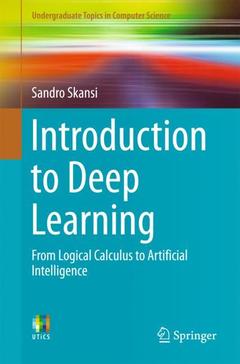Description
Introduction to Deep Learning, 1st ed. 2018
From Logical Calculus to Artificial Intelligence
Undergraduate Topics in Computer Science Series
Author: Skansi Sandro
Language: English
Subject for Introduction to Deep Learning:
Approximative price 52.74 €
In Print (Delivery period: 15 days).
Add to cartSupport: Print on demand
Description
/li>Contents
/li>Biography
/li>Comment
/li>
This textbook presents a concise, accessible and engaging first introduction to deep learning, offering a wide range of connectionist models which represent the current state-of-the-art. The text explores the most popular algorithms and architectures in a simple and intuitive style, explaining the mathematical derivations in a step-by-step manner. The content coverage includes convolutional networks, LSTMs, Word2vec, RBMs, DBNs, neural Turing machines, memory networks and autoencoders. Numerous examples in working Python code are provided throughout the book, and the code is also supplied separately at an accompanying website.
Topics and features: introduces the fundamentals of machine learning, and the mathematical and computational prerequisites for deep learning; discusses feed-forward neural networks, and explores the modifications to these which can be applied to any neural network; examines convolutional neural networks, and the recurrent connections to a feed-forward neural network; describes the notion of distributed representations, the concept of the autoencoder, and the ideas behind language processing with deep learning; presents a brief history of artificial intelligence and neural networks, and reviews interesting open research problems in deep learning and connectionism.This clearly written and lively primer on deep learning is essential reading for graduate and advanced undergraduate students of computer science, cognitive science and mathematics, as well as fields such as linguistics, logic, philosophy, and psychology.
From Logic to Cognitive Science
Mathematical and Computational Prerequisites
Machine Learning Basics
Feed-forward Neural Networks
Modifications and Extensions to a Feed-forward Neural Network
Convolutional Neural Networks
Recurrent Neural Networks
Autoencoders
Neural Language Models
An Overview of Different Neural Network Architectures
Conclusion
Dr. Sandro Skansi is an Assistant Professor of Logic at the University of Zagreb and Lecturer in Data Science at University College Algebra, Zagreb, Croatia.
Offers a welcome clarity of expression, maintaining mathematical rigor yet presenting the ideas in an intuitive and colourful manner
Includes references to open problems studied in other disciplines, enabling the reader to pursue these topics on their own, armed with the tools learned from the book
Presents an accessible style and interdisciplinary approach, with a vivid and lively exposition supported by numerous examples, connected ideas, and historical remarks

